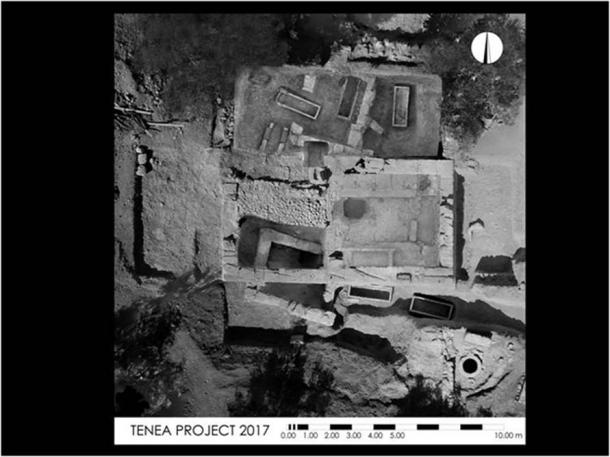
Valuable Jewels, Ornate Lamps and Coins Unearthed from 2,000-Year-Old Tombs in Corinth
A team of Greek researchers has unearthed unique jewels, coins and other precious artifacts while excavating tombs near the ruins of the ancient city of Corinth. Experts estimate that the newly found objects date between the fourth and first centuries AD.
Unique Jewels and Coins Excavated Near Ancient Corinth
Τhe team of scientists led by Elena Korka of the Greek Ministry, discovered the rare artifacts in eastern Corinthia, at the site of the ancient village of Tenea, during excavation works at a burial ground with two characteristic chambers built when Greece was part of the Roman Empire, as Newsweek reports. The Greek Ministry of Culture announced in a statement that the Greco-Roman burial structures were most likely constructed during a Hellenistic period between the death of Alexander the Great in 323 BC, up until the Battle of Corinth in 146 BC.
Archaeologists suggest that five of the better equipped tombs probably belonged to rich ancient Corinthian residents. The bodies were found alongside intricate gilded bronze leaves, a golden ring, valuable stones, as well as gold and bronze coins from the surrounding region as Newsweek reports. Other characteristic items of rituals buried with the dead included perfumes, artifacts made of gold, gold foil and beautifully crafted glassware, as well as items of pottery.

Gilded bronze leaves, a gold ring, valuable stone and coins were found. (Image: Greek Ministry of Antiquities)
Several Graves Organized in Circles
Furthermore, the researchers also excavated from the dig site many different burial plots. Interestingly, fourteen of the graves had been organized in circles – a common Roman tradition. These burials yielded gold and silver coins, vases, and lamps depicting the goddess Venus and two cupids. “Roman-period builders also repurposed the limestone foundations of earlier Greek structures to build the tombs for wealthy, Roman-era occupants,” Elena Korka said as Newsweek reports. Evidence of graves from the earlier Greek period was also traced in other areas of the dig site, including a figurine in the shape of a dove.
- Mycenean Tombs with Skeletal Remains Discovered near Legendary Nemea
- Agesilaus II, King of Sparta and Commander of Warriors
- The Time When Alexander the Great was ‘Defeated’

The Tenea dig site of 2017. (Image: Greek Ministry of Antiquities)
Greek Culture Conquered Its Roman Conquerors
By using the term “Roman Greece”, historians describe the period of Greek history following the Roman victory over the Corinthians, at the Battle of Corinth (146 BC), until the adoption of the city of Byzantium by the Emperor Constantine the Great as the capital of the Byzantine Empire. Regardless, some Greek cities (such as Pergamon) managed to maintain partial independence and avoid taxation. Most importantly, however, the Greeks were able to maintain a cultural autonomy from their Roman conquerors during the early period of empire, thanks to their rich civilization. Many temples and public buildings were built in Greece by emperors and wealthy Roman nobility, while this would become the longest period of peace in Greek history.

Items found included, gold items, glassware and pottery. (Image: Greek Ministry of Antiquities)
Even though a few Roman nobles regarded the Greeks as petty and inferior, the majority of Romans embraced Greek literature and philosophy. The Greek language became a favorite of the educated and elite Roman citizens, such as Scipio Africanus, who tended to study philosophy and regard Greek culture and science as an example to be followed.
Similarly, most Roman emperors maintained an admiration for things Greek in nature. Hadrian, for example, was known to be fond of the Greeks and before he would become emperor he served as an eponymous archon of Athens, where he constructed the famous Arch of Hadrian.
- More Orichalcum, the Atlantis Alloy, Turns Up with Helmets at a Sicilian Shipwreck, What Was its Use?
- Uncovering The Lost City of Helike
- The legendary Spartacus: Gladiator and leader of slaves against the Romans – Part 1

Arch of Hadrian, Athens. (CC BY-SA 3.0)
Corinth in particular – which was partially destroyed by the Romans in 146 BC – was rebuilt in 44 BC as a Roman city under Julius Caesar. Roman Corinth prospered more than any other Greek city at the time and according to various historical accounts, it had as many as 800,000 inhabitants by the time of Paul. It was the capital of Roman Greece, equally devoted to merchants and entertainment.
Generally speaking, one could say that life in Greece continued under the Roman Empire much the same as it had previously (minus the civil wars). And even though the exhausted Greek city-states after hundreds of years of wars (against each other in most cases) were conquered by the Roman military on the battlefield, it was Roman culture that was conquered by the Greeks, a fact that is best highlighted on Horace’s quotation, “Graecia capta ferum victorem cepit” (translated: Captive Greece captured her rude conqueror).
Top image: The findings included vases and a series of lamps, notably some included depictions of the Roman goddess Venus and two cupids. (Image: Greek Ministry of Antiquities)
















Comments
That photo showing the burial dig, what is that at bottom right ? a round hole, that a drain tube ? it is hard to see just what I am looking at of whole picture. also that ring with the gem on top, i have one exactly like it just my stone is smaller and, i made it myself :)